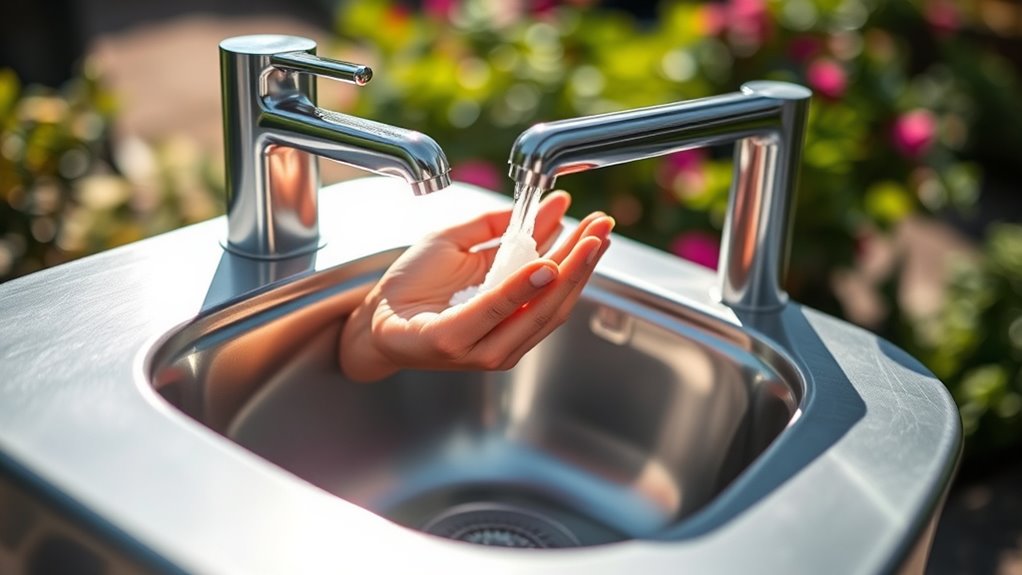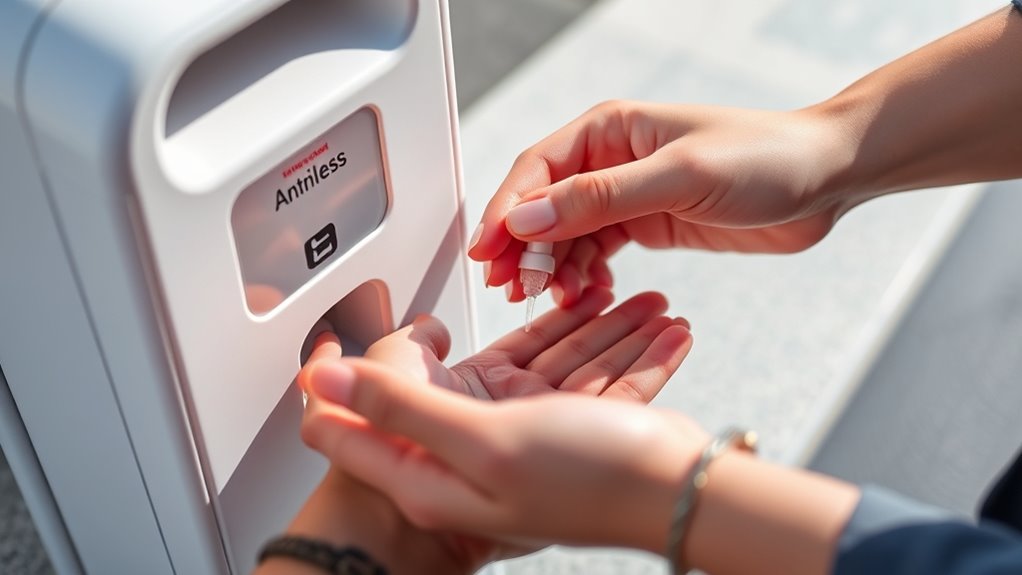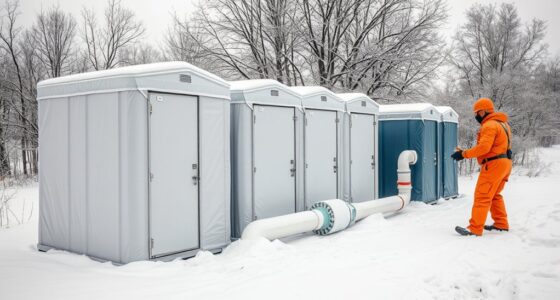Waterless handwashing stations are ideal when water isn’t available, such as during outdoor events, emergencies, or remote locations. To use them correctly, dispense enough sanitizer or cleansing solution and rub your hands thoroughly for 20 seconds, covering all surfaces including between fingers and under nails. Keep the station clean and refilled for peak hygiene. Knowing when and how to use these stations helps you stay healthy; discover more about best practices and maintenance next.
Key Takeaways
- Use waterless handwashing stations when water sources are unavailable or impractical, especially outdoors or in emergencies.
- Dispense enough sanitizer, then rub hands thoroughly for at least 20 seconds, covering all surfaces.
- Follow instructions displayed at the station to ensure effective hand hygiene.
- Regularly maintain stations by refilling sanitizer, cleaning surfaces, and inspecting for damage.
- Use frequently, especially after contact with shared surfaces or before eating, to prevent germ spread.

In situations where water access is limited or unavailable, waterless handwashing stations offer a practical solution to maintain hygiene. These stations are essential in settings like outdoor events, remote communities, and emergency response areas, where traditional handwashing facilities might not be accessible. To guarantee their effectiveness, you need to understand when and how to use them properly. First, it’s important to recognize that waterless handwashing isn’t just about convenience; it’s about preventing the spread of germs and ensuring public health. Proper hygiene education plays a key role here, as users must understand how to use these stations correctly to maximize their benefits. Clear signage and instructions help users understand that they should dispense the appropriate amount of hand sanitizer or cleansing solution, rub their hands thoroughly, and guarantee all surfaces are covered. Teaching community members or staff about the importance of hand hygiene and correct usage builds trust and encourages consistent use.
Maintaining waterless handwashing stations is equally essential to their success. Regular station maintenance guarantees the cleansing agents remain effective and that the stations stay clean and functional. You should routinely check the sanitizer levels and refill them before they run out, so users are never left without a means to clean their hands. It’s also vital to inspect the stations for any damage or leaks, which could compromise hygiene or make the stations unusable. Cleaning the station surfaces regularly prevents the spread of germs and dirt, maintaining a safe environment for everyone. Additionally, replacing any worn-out parts or refilling supplies as needed guarantees the station remains in prime working condition. Incorporating proper sanitation practices into routine maintenance helps ensure the stations continue to perform effectively and safely.
When it comes to actual use, you should remind users that waterless handwashing stations are a quick and effective alternative to traditional handwashing with soap and water. They’re especially helpful when water is scarce or the time is limited. Users should dispense enough sanitizer or cleansing agent, then rub their hands together for at least 20 seconds, covering all surfaces, including between fingers and under nails. Encourage everyone to use the stations frequently, especially after contact with shared surfaces or before eating. Promoting proper hygiene education and diligent station maintenance guarantees that these stations remain a dependable resource for preventing disease, fostering healthier communities even in challenging environments.
Frequently Asked Questions
Are Waterless Stations Suitable for Food Preparation Areas?
Yes, waterless stations are suitable for food preparation areas if they meet food safety standards. They help maintain restaurant hygiene by allowing quick hand cleaning without water, which reduces cross-contamination risks. You should use them before handling food, after touching trash, or when soap and water aren’t available. Properly maintained, waterless handwashing stations support safe food practices and enhance overall hygiene in your restaurant environment.
How Often Should the Hand Sanitizer Be Refilled?
Imagine a busy kitchen with hands constantly in motion—that’s when sanitizer refilling becomes critical. You should replenish the sanitizer before it runs out, typically every 4 to 6 hours, or whenever the level drops considerably. Regular sanitizer replenishment ensures effective hand hygiene and safety. Keep an eye on the dispenser, and make refilling frequency part of your routine to prevent shortages and maintain cleanliness.
Can Waterless Stations Be Used Outdoors in Extreme Weather?
Yes, waterless stations can be used outdoors in extreme weather, but you should consider outdoor durability. In very hot, cold, or wet conditions, guarantee the station is weatherproof and designed for outdoor use. Extreme weather can affect the sanitizer’s effectiveness and the station’s components, so choose models made for outdoor durability, and regularly check and maintain them to keep them functioning properly.
Are Waterless Handwashing Stations Environmentally Friendly?
Yes, waterless handwashing stations can be environmentally friendly when designed with sustainability considerations in mind. They reduce water usage and often rely on biodegradable or minimal waste products, lowering their environmental impact. By choosing stations made from eco-friendly materials and ensuring proper disposal or recycling of waste, you help minimize your carbon footprint and support sustainable practices, making these stations a greener alternative to traditional handwashing methods.
What Are the Costs Involved in Installing a Waterless Station?
Installing a waterless handwashing station involves initial installation costs that vary based on size and features, but you might find they’re more affordable than traditional setups. You’ll also need to budget for ongoing maintenance expenses, like replacing soap cartridges or batteries. While there’s an upfront investment, these stations can save money long-term by reducing water and staffing needs, making them a smart choice for many settings.
Conclusion
So next time you’re caught in a pinch, remember, waterless handwashing stations are your shiny, magical saviors—no tap needed, just a splash of sanitizer and voilà, germ-free hands! Who needs a dripping faucet when you can pretend you’re a high-tech spy cleaning your hands with a secret agent’s gadget? Embrace the convenience, and maybe, just maybe, you’ll start thinking they’re better than your old, boring sink. Stay clean, stay sneaky!









